用于处理重金属污染的水和环境修复的碳纳米材料
摘要
纳米技术是一门先进的科学领域,能够通过在纳米尺度上控制材料的尺寸和形状来解决各种环境挑战。碳纳米材料的独特之处在于它们的无毒性质、高表面积、更容易生物降解以及特别有用的环境修复。水中的重金属污染是一个主要问题,对人类健康构成巨大威胁。碳纳米材料由于其优越的理化性质而受到越来越多的关注,可用于重金属污染水的深度处理。碳纳米材料,即碳纳米管、富勒烯、石墨烯、氧化石墨烯和活性炭,由于它们的表面积大、纳米级尺寸和不同功能的可用性,因此具有从水中去除重金属的巨大潜力,并且它们更容易被化学改性和回收。在本文中,我们回顾了这些碳纳米材料在处理重金属污染水方面的最新进展,并重点介绍了它们在环境修复中的应用。还讨论了碳基纳米材料的毒理学方面。
介绍
污染被称为存在阻碍自然过程或对生物体和环境造成不利影响的不良化学实体 [1,2,3]。工业化和人口的大量增加导致城市化进程的加快导致污染以惊人的速度增加[2, 4]。改善水、土壤和空气质量是现代时代的一项巨大挑战。环境污染物的识别和处理及其预防是保护环境的关键步骤。材料科学在实现清洁环境目标方面发挥着至关重要的作用,材料科学技术在过去十年中呈指数级发展,尤其是纳米材料 [1, 5]。由于工业化,纯净水越来越稀缺,世界正面临清洁水短缺的问题,特别是在发展中国家[6]。水污染物可以是有机物、细菌、病毒、染料和重金属离子,如铅、镉、锌、镍、砷、铬和汞,具有不可生物降解的性质,对人类健康构成巨大威胁。重金属离子可引起许多不良反应,如癌症、肾损伤、肝炎、流产、贫血、脑病和肾炎综合征 [7,8,9,10]。铅离子通常从酸性铅电池的金属采矿业、造纸、玻璃和抛光行业释放到环境中。镉通常存在于电池、光伏电池、冶金过程和织物工厂的电镀设计排放的水中[11]。镍离子与首饰垃圾、拉链、手表、硬币等接触会引起皮肤病。铬金属离子 (VI) 会引起肝损伤、肾炎和胃痛等疾病,而 Cr (VI) 离子也是导致皮肤病的主要原因鼻粘膜溃疡[12]。图 1 显示了重金属离子在碳纳米材料(石墨烯)上的吸附,图 2 突出了环境中重金属污染的不同来源。由于这些严重的不利影响,从水中去除重金属离子对于挽救人类生命免受此类有问题的健康问题至关重要。有毒金属离子可以通过多种方法去除,如离子交换、反渗透、沉淀过滤、生物吸附、凝结和提取 [13, 14]。吸附被认为是去除痕量重金属离子的最佳方法,因为它具有成本效益、高效和易于操作的特点[15]。不同的材料已应用于水处理,例如植物吸附剂和有机材料,尤其是腐植酸,已广泛应用于水消毒和去除重金属离子 [8, 16,17,18,19]。王等人。综合综述了腐植酸及其纳米复合材料在水处理中的应用[20]。
<图片>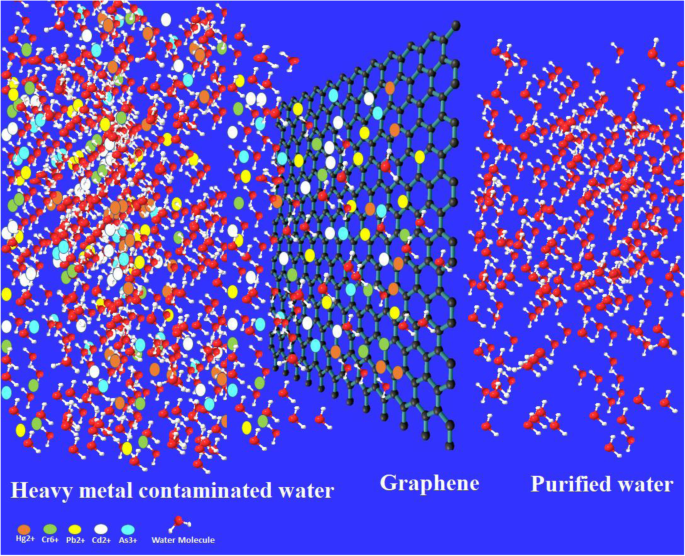
图形摘要显示使用石墨烯和其他碳基材料的重金属污染水净化过程也可以做到这一点
<图片>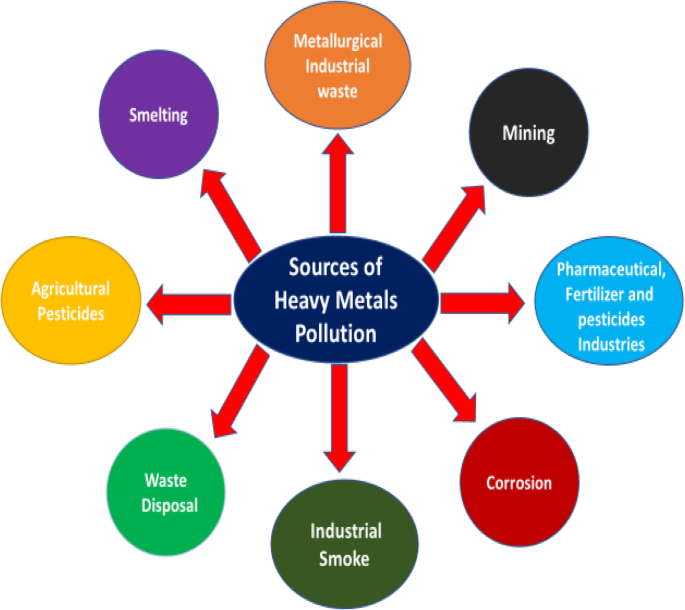
环境中重金属污染的来源
纳米技术平台几乎在每个领域都有应用,如环境科学、健康科学、电子、工业分离、便携式水处理大型/小型工厂、催化剂、储能和能源生产 [21,22,23]。由于纳米吸附剂的高表面积及其化学改性和更容易再生的能力,纳米材料为净化受污染的水提供了一个特殊的平台。越来越多的纳米材料被用于去除水中不同类型的污染物,即有机物、金属离子、生物污染物和砷 [24,25,26,27]。碳纳米材料,即石墨烯、氧化石墨烯、碳纳米管、富勒烯和活性炭,由于其优异的化学、机械、热、电气特性。在本文中,我们试图综述碳纳米材料即富勒烯、碳纳米管(CNTs)、石墨烯、氧化石墨烯和活性炭在净化重金属离子污染水方面的最新进展。
人体健康和重金属毒性
重金属通常是根据它们的原子量来定义的;然而,术语重金属也指对生物有毒的元素 [28]。某些重金属以不同的形式和剂量对人类健康和其他生物是致命的(表 1)。通常,重金属被认为是有毒的。然而,较轻的金属也可能是致命的,例如铍和锂。并非所有的重金属都对健康有害,因为有些是基本的,例如铁和 Cr (III)。最常见的有毒金属是 Pb、Cd、Cr、Mn、Hg、As 和放射性金属。放射性金属具有放射性和化学毒性。重金属毒性已被证明是一个主要威胁,并且存在许多与之相关的健康风险。这些金属的致命影响是它们没有任何生物学作用;然而,它们可能会模仿身体的一个元素并干扰代谢和其他生物过程。一些金属如铝很容易被排泄系统清除,而某些金属则在食物链和身体中积累。金属诱导的毒性取决于剂量、接触途径和接触时间(例如,急性或慢性)。与不同重金属相关的毒性详情如下。
汞 (Hg) 的毒性
汞 (Hg) 是一种 d 区元素,原子序数为 80,在标准条件下呈液态。汞存在于称为朱砂的硫化汞沉积物中。汞污染是由制药行业、纸浆和造纸行业、烧碱生产行业、农业行业等引起的[47]。汞是环境中毒性最大的重金属,汞中毒被称为粉红病,也称为肢端痛。汞可以与有机和无机化合物结合。任何形式的汞暴露水平升高都会损害肾脏、大脑、发育中的胎儿等 [48]。环保机构已宣布甲基汞和氯化汞为致癌物质。汞暴露还会导致肺损伤、皮疹、记忆问题和脱发。世界卫生组织 (WHO) 已将饮用水中汞含量较低的标准设定为 0.01 mg/l [29]。
铅 (Pb) 的毒性
铅 (Pb) 是一种原子序数为 82 的元素,被认为是一种具有银蓝色外观的重金属,在空气的作用下会变成暗灰色 [30]。铅污染的来源多种多样,主要是电池工业废物、化肥和农药、金属电镀和精加工操作、尾气、汽油中的添加剂、汽车中的颜料和矿石冶炼。由于其广泛使用,这种重毒金属正在成为全球环境和健康问题[31]。铅 (Pb) 是美国环境保护署 (EPA) 宣布的致癌元素。铅中毒是用于其毒性的术语,它可以是急性的或慢性的。铅中毒可导致智力低下、自闭症、过敏、阅读障碍、瘫痪、脑损伤和肾损伤等先天缺陷,也可能导致死亡[32]。
砷 (As) 的毒性
砷是一种原子序数为 33 的准金属元素,通常以矿物形式与硫、一些其他金属、铁盐、钙盐、钠盐和铜结合存在,也以纯元素形式存在 [33]。水被含砷农药、天然矿物质沉积物以及含砷试剂或化学品的不当处置所污染。以砷酸盐和亚砷酸盐形式存在的砷对环境和生物是致命的。砷通过与细胞的巯基相互作用而扰乱细胞的原生质,导致呼吸功能障碍并影响有丝分裂和细胞酶[34]。
镉 (Cd) 的毒性
镉的原子序数为 48,是一种蓝白色的软金属,其化学性质类似于第 12 族的汞和锌 [30]。它们是通过矿石冶炼、电镀、电池、增塑剂、合金、颜料、核工业和香烟烟雾来生产的。一般来说,环境中的镉含量很低;然而,工业废物大大增加了这些水平。镉引起的毒性会对肾脏、呼吸系统和骨骼造成损害,并且对人类具有致癌性 [30, 33]。镉被有毒物质和疾病登记署 (ATSDR) 列为第七大毒性金属 [34]。
铬 (Cr) 的毒性
铬 (Cr) 是一种原子序数为 24 的元素,外观呈钢灰色 [35]。铬以不同的状态存在,例如二价、四价、五价和六价状态;然而,三价和六价形式是最稳定的。铬 (III) 是人类和动物必不可少的营养补充剂 [35]。然而,铬 (VI) 形式在自然界中具有剧毒和致癌性 [36, 37]。铬在不同来源的环境基质(空气、水和土壤)中产生,例如主要从冶金和化学工业排放的废水和空气。六价铬 Cr (VI) 是一种工业污染物,已确定为人类致癌物 [38, 39]。地下水和地表水中的 Cr (VI) 浓度超标,世界卫生组织 (WHO) 规定每升 50 μg [40]。
锌 (Zn) 的毒性
锌 (Zn) 是原子序数为 30 且位于元素周期表第 2 族中的元素。虽然锌是人体必需的微量金属,但过量吸收锌会抑制铁的吸收。锌离子对植物、脊椎动物、鱼类、无脊椎动物等有剧毒[41,42,43]。
基于尺寸的碳纳米材料分类
三个维度都小于100 nm的纳米材料称为零维(0-D)纳米材料;例子是富勒烯和量子点 [44]。只有一维大于 100 nm 和二维小于 100 nm 的纳米材料被称为一维 (1-D) 纳米材料,例如碳和钛的纳米管 [45, 46]。二维大于100 nm的纳米材料称为二维纳米材料,一个著名的例子就是石墨烯。所有尺寸大于100 nm的三维材料称为三维(3-D)材料;例如石墨和一些纳米材料的复合材料 [46]。图3展示了一些具有代表性的不同尺寸的著名结构碳材料,例如富勒烯0-D、单壁碳纳米管1-D、石墨烯2-D和石墨3-D。
<图片>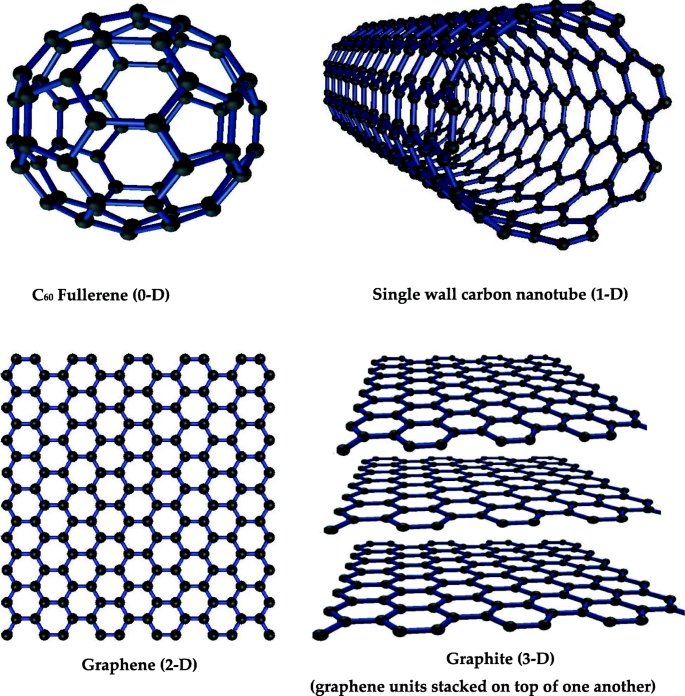
不同尺寸碳纳米材料的例子
富勒烯在环境修复和水净化中的应用
富勒烯是1985年从星际尘埃中发现的,具有封闭的五边形和六边形环结构,用C20 + m表示 其中 m 是一个整数 [49]。它们具有疏水特性、高电子亲和力和高表面体积比以及表面缺陷。这些独特的物理化学特性使其成为各种应用的理想材料,例如半导体、电子、生物医学、太阳能电池、传感器、化妆品、人工光合作用和表面涂层 [50,51,52]。布鲁内特等人。表明亲水官能化富勒烯(C60)也已通过光催化过程用于杀死水中的病原微生物。富勒烯也是用于储氢的理想清洁绿色材料,因为碳和氢的键能较低,因此富勒烯分子可以很容易地转化为 C-C 键和 C-H [27]。据报道,富勒烯由于其化学结构和笼状分子结构而具有 6.1% 的最大储氢量,并且由于 C-C 键能较高,富勒烯结构很容易逆转 [3, 53, 54]。碳导电层应用于超级电容器的电极表面,其电容取决于表面积、孔径分布和电导率 [55, 56]。由于更高的表面积,碳基纳米材料提供比传统可用材料更高的导电性 [57]。据报道,基于富勒烯的复合材料具有更高的比电容,为 135.36 Fg − 1 与未与富勒烯杂化的纯石墨烯材料相比。除此之外,即使在 1000 次充电/放电循环后,基于富勒烯的复合材料也表现出更好的保留时间率,达到 92.35% [58]。富勒烯也被用于锂离子电池作为阳极,并通过替代不可降解的金属阳极提供更好的效率,从而证明在效率和环境友好的材料方面是有益的。富勒烯的理化特性也使它们成为从水介质中提取不同物质的合适候选物 [59, 60]。皮克林等人。设计了水溶性富勒烯化合物,并成功地将它们用作敏化剂,在可见光和紫外线辐射下在水中产生活性氧 (ROS)。 ROS 可以光降解水中的有机污染物,除此之外,水溶性富勒烯(富勒醇)还具有抗氧化剂的作用。最重要的是,富勒醇在执行光降解功能后可以很容易地从水中去除[53]。
据信,富勒烯通过吸附物渗透到碳纳米团簇之间的空间/缺陷中来吸附物种,除了缺陷之外,较低的聚集趋势和大的表面积使它们成为有用的纳米材料,可用于吸附来自碳纳米团簇的重金属离子。水 [61, 62]。阿列克谢耶娃等。富勒烯和纳米复合聚苯乙烯薄膜去除Cu 2+ 的对比研究 离子;他们发现富勒烯显示出更好的效率 [60]。他们还发现富勒烯对 Cu 2+ 的吸附遵循朗缪尔模型 离子 [60]。他们确定 Cu 2+ 第一种情况下富勒烯的去除效率更高,Cu 2+ 的平衡等温线 富勒烯上的吸附符合朗缪尔模型。尽管富勒烯在吸水应用方面具有巨大潜力,但其成本过高限制了其应用。然而,微量的富勒烯可用于制造其他材料,如活性炭、木质素和沸石,以提高它们的吸附效率 [63]。富勒烯的制造增加了疏水特性,使材料更好地应用于吸附,也有助于更容易回收[64]。据报道,通过用聚乙烯吡咯烷酮 (PVP) 接枝富勒烯 C60 形成抗菌材料,该材料具有用于水消毒的潜力。膜技术在净化水中的盐分、有机物、颗粒和气体方面越来越受到重视。膜性能取决于材料的组成,因为它决定了反应性、选择性和机械强度。富勒烯具有易于功能化、电子亲和力高、强度大、尺寸可调等优点,在膜技术中具有强大的应用潜力。富勒烯可方便地接枝纳米吸附剂以提高其吸附效率。
富勒烯的生物相容性
基于富勒烯的纳米材料已被用于生物医学应用,不同的研究揭示了它们与生物体的生物相容性。它已被用作生物受体和生物传感器,也被用于生物医学工程,据报道它与生命系统具有生物相容性 [65,66,67,68,69]。富勒烯是一种无毒材料,可用于过滤、吸附剂和用于环境和水处理应用的膜材料。
碳纳米管 (CNT)
碳纳米管由 Lijima 于 1999 年发现,它们可以是单壁 (SWCNT),例如分层卷起的石墨烯,或多壁碳纳米管 (MWCNT),例如,多层卷起的石墨烯 [70]。碳纳米管由于其独特的物理化学性质,自被发现以来一直是纳米技术研究的焦点。这些圆柱形的碳纳米结构同素异形体正被应用于电子、半导体、场发射、能量存储、催化、生物医学、空气和水过滤器等领域。它们的直径可以从 1 nm 到几纳米,具有很大的比表面积(150– 1500 米 2 /g),并且它们具有中孔,这使它们成为通过吸附去除重金属离子的理想候选者 [71, 72]。除此之外,碳纳米管可以很容易地用各种有机分子进行功能化,这可以使它们对吸附物的选择具有特异性,并且可以提高它们的吸附能力[73]。碳纳米管对重金属的吸附机制依赖于表面特征、电化学势和离子交换过程[11, 73]。
碳纳米管/基于碳纳米管的绿色技术的环境应用
全球能源需求急剧增加,人们正在努力开发一种简单、经济、环保的材料,用于能源材料的可靠技术。太阳能是通过太阳能电转换和太阳能热转换产生的[74]。然而,太阳能集热器的热转换效率低是主要障碍。
碳纳米流体因其作为太阳能吸收器的良好性能而被广泛应用于太阳能热转换[75]。基于碳纳米管的光伏电池 (PVC) 是一种具有优异迁移率的 p 型半导体,并且与电子供体的结合是一种新颖而独特的想法,因此受到了科学家们的广泛关注 [76, 77]。通过用聚合物制造碳纳米管,可以很容易地设计有机光伏器件[78]。已经设计了基于 CNT -Si (p-n) 异质结的太阳能电池,从而产生出色的导电和透明薄膜。除此之外,还报道了具有 n 型砷化镓 (n-GaAs) 的碳纳米管,用于绿色激光和台灯的效率更高,为 3.8% [79]。碳纳米管也被广泛利用的储能设备,其工作原理是基于电化学双层电容器 (EDLC) 的原理,如超级电容器 [80]。在超级电容器的电极中加入 CNT 导致寿命大大提高,超过 300,000 次循环 [81]。除此之外,超级电容器 CNT 还被用于二极管而不是传统的晶体管,因为它们具有出色的机械和电气特性,可以制作完美的 p-n 结 [58]。碳纳米管还被广泛用于先进的传感器技术,因为它们可以提高化学和生物传感器的灵敏度、选择性、响应时间、成本效益和寿命 [90]。这些结果表明,更好的碳纳米管是理想的材料,具有优异的迁移率和更高的效率,对环境没有负面影响,这是最常用的金属基 p 型材料的主要缺点。
碳纳米管在光催化中的应用
光催化是应用于利用半导体的废水处理的先进技术之一[82]。正在应用各种半导体材料,即 Fe3O4、ZnO 和 TiO2;然而,这些材料的量子效率并不高,除此之外,它们的紫外光响应也很慢[83]。碳纳米管具有更高的量子效率、纳米尺寸、高化学稳定性、中空管结构以及由于其大比表面积而扩展的光吸收区域,因此是有前途的先进催化材料[84]。高等人。设计了基于超薄网络光催化剂的 SWCNTs-TiO2,并成功应用于从油中纯化水[85]。帕克等人。在 SWCNT 的气凝胶上装饰二氧化钛并成功应用于去除水中的亚甲蓝 [86]。赵等人。制造的 MWCNTs-TiO2 并应用于亚甲基蓝的光降解 [87]。徐等人。通过羟基-MWCNTs和PbO2纳米晶阳极的结合设计了光催化剂,并成功地将其应用于去除水中的吡啶[88]。
单壁碳纳米管净化重金属污染水
SWCNT 是一维 (1-D) 碳纳米材料,由管壁为一个原子厚的空心管组成。由于其独特的结构,这种一维材料表现出卓越的物理化学特性。 SWCNT 正被广泛应用于半导体、电子、生物医学、化学和生物传感器等不同领域 [44, 89,90,91,92,93]。单壁碳纳米管由于其多孔结构、高表面积、更容易的表面功能化和纳米尺寸,也被广泛用于环境污染控制。 SWCNTs的这些特性对于它们在水处理中的应用非常有前景。阿里贾尼等人。通过用磁铁矿硫化钴制造它们设计了基于 SWCNT 的纳米复合材料,并将所得纳米复合材料用于去除汞;结果表明,在 7 min 的较短时间内吸附率超过 99.56% [94]。与此相比,单单壁碳纳米管被发现吸附 45.39% 的汞 [94]。安妮莎等人。对裸单壁碳纳米管及其功能化对应物(如单壁碳纳米管-OH、单壁碳纳米管-NH2 和单壁碳纳米管-COOH)对重金属离子(如 Cd 2+ )的吸附能力进行了分子动力学模拟 , 铜 2+ , Pb 2+ , 和 Hg 2+ 来自水介质。结果表明,与裸单壁碳纳米管相比,单壁碳纳米管-COOH 的吸附能力高出约 150-230%。发现 SWCNTs-OH 和 SWCNTs-NH 的吸附力较弱,因为与 SWCNTs 相比,它们的吸附量仅高出 10-47% [95]。 SWCNTs-COOH也被报道用于吸附Pb 2+ , 铜 2+ , 和 Cd 2+ 离子的吸附容量分别为 96.02、77.00 和 55.89 mg/g。与此相比,发现非功能化 SWCNT 对 Pb 2+, 的吸附量为 33.55、24.29 和 24.07 mg/g 铜 2+ , 和 Cd 2+ 离子 [96]。扎祖利等人。通过用 l-半胱氨酸对其进行功能化来设计 SWCNT 纳米复合材料。他们应用设计的纳米复合材料去除水中的汞。发现设计的 SWCNTs-半胱氨酸的吸附效率为 95% [97]。古普塔等人。设计了基于 SWCNTs-聚砜纳米复合材料的膜,并应用于去除重金属。 SWCNT 的掺入导致膜孔径的减小和更光滑的表面。发现设计的膜对金属离子显示出高截留能力并去除了 96.8% Cr + 6 , 87.6% As + 3 , 和 94.2% Pb + 2 离子。没有 SWCNT 的膜对 Cr + 6 的截留率只有 30.3%、28.5% 和 28.3% , As + 3 , 和 Pb + 2 离子分别。这些结果表明,由于掺入了单壁碳纳米管 [98],膜的效率得到了提高。德加尼等人。应用 SWCNTs 去除 Cr + 6 离子并评估不同参数的影响,例如接触时间、初始 pH 值和初始 Cr + 6 离子浓度对吸附能力的影响。据观察,吸附效率取决于 pH 值,最大效率在 pH 2.5 时发现,并且吸附遵循朗缪尔等温线模型 [99]。这些研究表明单壁碳纳米管适用于重金属污染水的处理。
多壁碳纳米管净化重金属污染水
具有多层石墨烯轧制层的碳纳米管称为多壁碳纳米管 (MWCNT),如图 4 所示。MWCNT 表现出独特的特性,例如高表面积、高导电性、导热性和高拉伸强度 [100]。由于这些物理化学特性,它们被广泛应用于电子、太阳能电池、传感器和生物医学科学 [101,102,103]。多壁碳纳米管在水处理中也得到了广泛的应用,特别是重金属离子通过与多壁碳纳米管的官能团发生化学作用而被吸附。据报道,氧化的多壁碳纳米管对 Cr 6+ 具有高吸附能力和效率。 , Pb 2+ , 和 Cd 2+ 来自水中的离子 [104, 105]。金属离子的吸附也取决于pH值,通过改变pH值可以将这种特性应用于离子的解吸,并且MWCNTs可以被重新利用。一些研究表明,等离子体氧化的多壁碳纳米管比化学氧化的多壁碳纳米管具有更好的吸附性能;这可以归因于碳纳米管表面上存在更多数量的氧化官能团。此外,据报道,等离子体氧化的多壁碳纳米管可以很容易地回收和再利用[72, 106]。
<图片>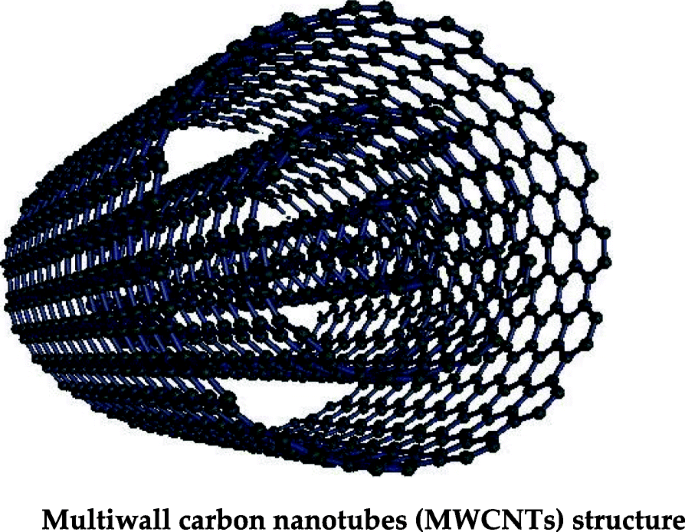
多壁碳纳米管(MWCNT)结构
MWCNTs的复合材料也被用于从水中吸附重金属离子。 MWCNTs-Fe2O3、MWCNTs-ZrO2、MWCNTs-Fe3O4、MWCNTs-Al2O3和MWCNTs-MnO2-Fe2O3纳米复合材料已成功应用于去除Cr 6+ 的重离子 , As 3+ , Ni 2+ , Pb 2+ , 和 Cu 2+ 水中的离子 [107,108,109,110]。溶液的实验条件,包括 pH 值和金属离子浓度,会影响多壁碳纳米管的吸附特性,其实验数据满足 Freundlich 吸附模型[81, 111]。与其他有机氧化物材料相比,功能化多壁碳纳米管的吸附效率有所提高,而且据预测,功能化多壁碳纳米管的金属离子吸附效率是未氧化多壁碳纳米管的 20 倍 [112]。一般认为,离子的联系和碳纳米管极性表面的发生是吸附的主要机制,[113, 114]。氧化的多壁碳纳米管还显示出对 Pb 2+ 的极高吸附能力和效率 , Cd 2+ , 和 Cr 6+ 从水中。多壁碳纳米管经酸处理后的吸附效率增加了去除铅、铬和镉离子的潜力,氧官能团在表面形成离子复合物或盐沉淀物 [115]。用浓 HNO3 处理的 MWCNTs 的吸附显着增加,这主要是由于酸化纳米管表面产生的氧官能团,可以与金属离子反应在表面形成络合物或盐沉淀物。 The MWCNT composites with certain compounds like iron (III) oxide, zinc oxide, and aluminum oxide are formed by a coprecipitation method, and resulting composites are successfully applied for the removal of chromium, nickel, lead, copper, and arsenic ions. The adsorption efficiency of these nanocomposites was found to be dependent on the pH value and temperature, and the sorption process can be accomplished by changing these parameters [116, 117]. Depending on the pH and temperature, the sorption capacity of these composites varied from 10 to 31 mg/g. The adsorption process for these nanocomposites was well described by the Langmuir model [118]. The nanocomposites of oxidized multiwalled MWCNTs with manganese oxide/iron (III) oxide are reported to remove Cr 6+ ions with maximum adsorption capacity of 186.9 mg/g with the maximum removal capacity of 85% at the optimum pH 2.1 studies. Their promising adsorption was due to the surface polarity of the adsorbents. It has also been reported that plasma-oxidized MWCNTs are better in adsorption compared to chemically oxidized ones as the prior ones have more oxygenated functional groups [119]. Plasma-oxidized technique has also been reported for the formation of nanotubes with titanium oxide and manganese dioxide and utilized for the removal of lead ions from water. The results showed that these hybrid systems can act as an effective adsorbent for the lead ions in the first case; the adsorption capacity was 137 mg/g, and in the second case, it was 78.74 mg/g [120]. In a heterogeneity adsorbent surface, sites combined twice are fitted in the isotherms models of the Langmuir-Freundlich equation that was used to differentiate between two types of adsorption sites with greater and lesser energy affinities for the Ni 2+ ions [121]. It is believed that nickel ion sorption mainly occurs at the sites of energy with modified nanocomposites of MWCNTs and the nano-modification leads to a 20% increase in the adsorption capacity at small (up to 0.1 mol/l) equilibrium adsorbate concentrations. Another modification reported for MWCNTs is their functionalization with hydroxyquinoline and their application for the removal of copper, lead, cadmium, and other toxic ions [122]. The carbon nanotubes alone as well as in their oxidized and in their composite forms have tremendous ability to adsorb the heavy metal ions, and a lot of research is in progress for their applications in purification of water. Elsehly et al. applied commercial MWCNTs for the removal of the manganese and iron which could reach 71.5% and 52% respectively with a concentration in aqueous solution of 50 ppm of these metal ions [123]. In another study, CNT-based nanocomposites have been applied for the removal iron and manganese from the water [124].
Biocompatibility of CNTs
Carbon nanotubes have great potential to be applied for multidisciplinary fields like drug delivery, diagnosis, biosensors, electronics, semiconductors, and environmental remediations [125]. Different studies revealed the biocompatibility of CNTs as it has been widely exploited for biomedical applications [126, 127]. Carbon-based materials like CNTs are safe to be applied for the environmental remediation and in particularly for water treatment.
Graphene Based Material for Environmental Remediation
Graphene-based material for the adsorption of gaseous contaminants
Carbon dioxide (CO2) has been the environmental concern because of its immense effect in global warming [128]. Nanomaterials have been found to be promising materials as compared to conventional materials both with respect to cost and efficiency [129]. Graphene-based materials have been utilized for the adsorption of gaseous contaminants [130]. Gosh et al. showed the successful application of graphene-based nanomaterials for the capture of CO2 and H2. A single layer of graphene has been reported to capture 37.93% of CO2 [130]. Graphene has been reported to selectively adsorb CO2 as compared to methane (CH4) and nitrogen (N2) gases. Selectivity of graphene oxide (GO) for CO2 can be attributed to higher dipole moment of carbon dioxide which can easily interact with polar oxygenated functional groups of CO2 [74, 131]. Other studies have also been reported for tuning the graphene chemistry for the improved selectivity of the desired gaseous contaminant [75, 131].
Graphene Oxide in Removal of Organic Dyes from Water
Graphene-based nano-adsorbents are excellent advanced materials for the removal of the organic contaminants from the water because of their nano-scaled size, high surface area, ability to interact via pi-pi stacking, hydrogen bonding, and electrostatic interactions [26]. In comparative adsorption studies of GO and graphite using methylene blue and malachite green as standard organic dyes, it was found that GO showed much better adsorption than graphite [26]. GO has also been utilized for the removal of cationic dyes namely methylene blue (MB), crystal violet (CV), and rhodamine B (RhB) from water. It was found that the higher the initial dye concentration, the higher will be the adsorption with adsorption capacities of 199.2, 195.4, and 154.8 mg g −1 for MB, CV, and RhB, respectively [76]. GO has also successfully applied for the removal of anionic dyes like Acid Orange 8 (AO8) and Direct Red 23 (DR23) from aqueous solutions [77].
Graphene-Based Photocatalytic Materials for Water Decontamination
Although adsorption can remove the contaminant from water, the adsorption technique is unable to destroy/degrade the contaminants and disposal step is required [77]. Photocatalysis is a useful approach for water remediation/wastewater treatment for the complete degradation and mineralization of organic/biological contaminants [78]. Graphene-based photocatalysts have been reported for their improved activity because of their high surface area, nanosize, and more electronic movements as compared to the traditionally used materials [78, 132]. Rommozzi et al. designed reduced graphene oxide (rGO) with a greener reduction method using glucose and ammonium hydroxide and successfully designed a photocatalyst which is visible by the fabrication with TiO2. The designed rGO-TiO2 photocatalyst was successfully applied for the refractory dye named Alizarin Red S (ARS) [133]. In other studies, graphene oxide fabricated with TiO2 and ZnO exhibited much photodegradation of methylene blue as compared to TiO2/ZnO alone [79, 80].
Graphene and Graphene Oxide-Based Adsorbents for the Purification of Heavy Metal-Contaminated Water
Graphene is one-atom-thick-layered hexagonal lattice of carbon atoms and is known as the thinnest material with the strength of 200 times than steel. Graphene was discovered in 2004 by Sir Andre Geim and Sir Konstantin Novoselov, who were awarded a Nobel prize for their discovery in 2010. Graphene (2-D) is being used widely in almost every field such as in touch screens, mobiles, LCDs, semiconductors, computer chips, batteries, energy generation, water filters, supercapacitors, solar cells, and biomedical and environmental sciences [134,135,136,137]. These 2-D graphene-based materials are getting more and more attention in water treatment due to their unique physicochemical characteristics namely electronic properties, high surface area, thermal mobility, high mechanical strength, and tunable surface chemistry [118, 134, 138, 139]. Tabish et al. designed porous graphene and applied it as an adsorbent for the removal of heavy metal ions as well as other pollutants from water. They applied this porous graphene material for As 3+ removal from water and found 80% efficiency. The material was found to retain its water treatment properties after regeneration and recycling [138].郭等人。 designed a nanocomposite of partially reduced graphene oxide by its fabrication with Fe3O4 via in situ co-precipitation method and applied it for the removal of Pb 2+ ions from water. The designed nanocomposite was found to be excellent in removing the Pb 2+ ions from aqueous solution with an adsorption capacity of 373.14 mg/g [140].张等人。 functionalized the reduced graphene oxide with 4-sulfophenylazo (rGOs) and applied it for the removal of a variety of heavy metal ions from aqueous solution. The designed material showed the maximum adsorption capacity of 689, 59, 66, 267, and 191 mg/g for the Pb 2+ , 铜 2+ , Ni 2+ , Cd 2+ , and Cr 3+ respectively [141]. Diana et al. designed a graphene-based self-propelled microbot system whose structure was made up of nanosized multilayered consisting of graphene oxide, nickel, and platinum. Each layer performed a different function, e.g., graphene oxide captures the heavy metal Pb 2+ ions, the middle layer of Ni enables the control of microbots with the help of external magnetic field, and the inner layer of platinum helps the engine in self-propelling [142]. The designed system was found to remove the 80% of the Pb 2+ water solution. Figure 5 shows the schematic illustration of the working principle of microbots.杨等人。 designed hydrogen beads using graphene oxide and sodium alginate (GO-SA) and successfully applied them for the removal of Mn 2+ ions from the aqueous solution with excellent adsorption capacity of 56.49 mg/g [9].郑等人。 designed nanocomposites by fabrication of zinc oxide with tea polyphenol with reduced graphene oxide (TPG-ZnO). Designed material was applied for the removal of heavy metal ions with an added advantage of antibacterial properties [143]. They applied this material for the removal of Pb 2+ ions from aqueous solution with adsorption efficiency of 98.9%, and the adsorbent was found to possess antibacterial properties against Streptococcus mutans with 99% eradication [143]. Mousavi et al. designed nanocomposites of graphene oxide with iron oxide magnetite nanoparticles Fe3O4 and applied them for the removal of Pb 2+ ions from water and the material showed 98% removal efficiency with a capacity of 126.6 mg/g [144]. Considering functionalized graphene as an adsorbent to remove Pb 2+ ions from an aqueous medium, the highest record of Pb 2+ ion removal over graphene is 406.6 mg/g at pH of 5.0 in 40 min [145]. Graphene-hydrogel lingo sulfonate functionalized nanocomposites having oxygenated functional groups making the surface highly polar reported to increase the rate of adsorption of Pb 2+ ions with maximum efficacy of 1308 mg/g with the equilibrium reached in 40 min. Awad et al. modified graphene oxide with chloroacetic acid (GO-COOH) and ethylenediamine (GO-amino). The designed systems were applied for the removal of mercury (Hg 2+ ) from water and found that the nanocomposites (GO-COOH) and (GO-amino) have an adsorption capacity of 122 mg/g and 230 mg/g. In addition to this, designed systems retained their adsorption efficiency after the recycling process [146].严等人。 designed magnet graphene oxide for the rapid removal and separation of Fe (II) and Mn (II) from micropolluted water [147]. Ali et al. designed graphene-based adsorbent successfully for the removal of noxious pollutants namely Cu (II), Pb (II), Fe (II), and Mn (II) [148].
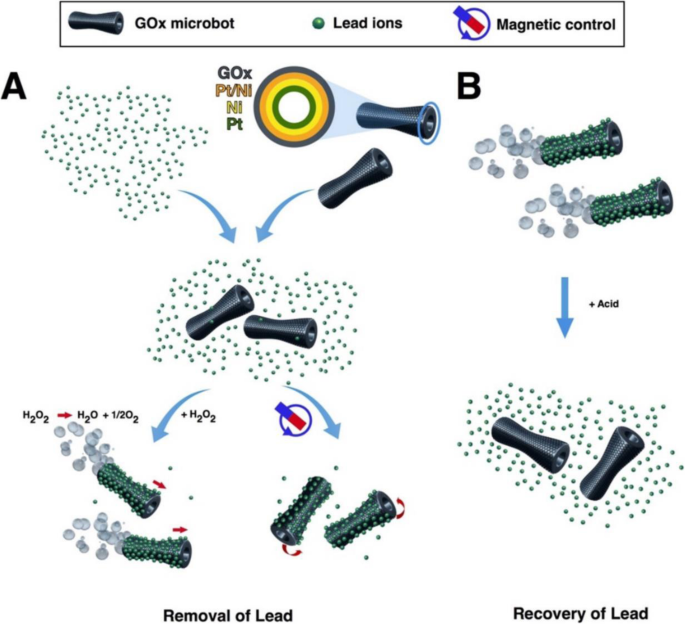
Scheme of GOx-microbot-based approach for lead decontamination and recovery. 一 Decontamination of polluted water using GOx-microbots fabricated by electrodeposition of nanolayers of graphene oxide (GOx), Pt/Ni layer, Ni magnetic layer, and Pt catalytic inner layer. The decontamination strategy for lead ions can be carried out by two different techniques:self-propulsion of the GOx-microbots in the presence of H2O2 or by using an external rotating magnetic field. b Recovery of lead ions from the GOx-microbots in the presence of acidic media [117]
Biocompatibility of Graphene-Based Nanomaterial
Graphene-based nanomaterials have been applied in different fields like electronics, chemical sensors, biosensors, drug delivery, theragnostic, and other related biomedical fields. These studies also report the cytocompatibility of graphene-based materials both by in vitro as well as in vivo animal studies [122, 133, 149,150,151,152]. These findings suggest that the graphene-based materials are safe for the environmental remediation application as they are just used for the removal and degradation of pollutants and are not consumed by humans directly.
Activated Carbon in Environmental Remediation
Activated carbon is a fabulous material because of its high surface area, highly porous structure, and ease of preparation with variety of starting materials. Because of its ideal physicochemical properties, it has wide application in environmental remediations in different industries like pharmaceutics, fertilizer plants, petroleum, cosmetics, automobiles, and textiles [153] It is also widely applied for the adsorption of gases, solvent recovery, and wastewater treatment especially for the removal of organic dyes/other pollutants; not only this, but it is also used as a catalyst in biodiesel production. It is also applied as a low-cost material for the treatment and removal of water containing COD, BOD, and TSS and stabilizing and maintaining the optimum pH for biological uses [154,155,156]. Maguana et al. prepared activated carbon from the pear seed cake and successfully applied it for the removal of methylene having an adsorption capacity of 260 mg/g [157]. Antonio et al. prepared activated carbon from the kenaf plant and applied it successfully for the treatment of the wastewater of hospitals containing paracetamol as the main pollutant [158]. The above literature suggests that the activated carbon is the pretty useful economical material which can easily be prepared and it has immense application in environmental remediations.
Activated Carbon as Adsorbents in the Purification of Heavy Metal-Contaminated Water
Activated carbon (AC) is also known as activated charcoal, and this of type carbon material is formed under some treatment protocols resulting in micro/nanopores and having the large surface area of more than 3000 m 2 [159]. The AC is produced on a large scale from coal, wood, and agricultural wastes [160]. In addition to its porous nature (as shown in Fig. 6), AC also has a high mechanical strength which enables its applications in catalyst support, capacitors, electrodes, and gas storage and most importantly used as the adsorbent for removal of metal ions, organic wastes, and gases from water [160,161,162]. The high mechanical strength of activated carbon enables its periodic cleaning, regeneration, and reutilization [160]. Abeer et al. reported the preparation of AC from apricot stone and its application in removal of Zn + 2 and Al + 3 ions with removal efficiency of 92% [163]. Ebrahim et al. designed AC from sewage sludge, applied it for the removal of Cu + 2 ions from water, and found that the designed material showed maximum adsorption capacity of above 50% [164].
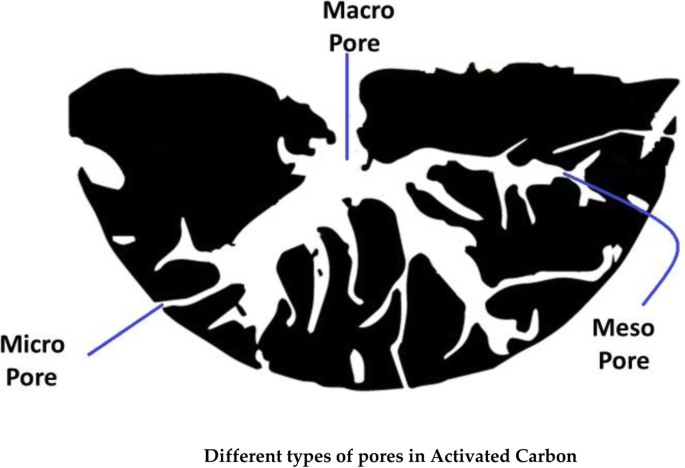
Different types of pores in activated carbon
李等人。 prepared the AC from sewage sludge produced from the wastewater treatment plant and functionalized it with sulfur [165]. They applied sulfonated AC for the removal of Pb 2+ , Cd 2+ , 铜 2+ , 和 Ni 2+ ions from water. The adsorption capacity of metal ions were found to be 238.1 mg/g, 96.2 mg/g, 87.7 mg/g, and 52.4 mg/g for Pb 2+ , Cd 2+ , 铜 2+ , 和 Ni 2+ respectively [165].曹等人。 designed multipore activated carbon (MPAC) with a large surface area using the agricultural waste of long-root Eichhornia crassipes and applied it for removing heavy metal ions, e.g., Pb 2+ , Cd 2+ , 铜 2+ , Ni 2+ , 和 Zn 2+ . They found that at 30 °C adsorption capacity being 1.34 mmol/g, 1.07 mmol/g, 1.22 mmol/g, 0.97 mmol/g, and 0.93 mmol/g for Pb 2+ , Cd 2+ , 铜 2+ , 和 Ni 2+ respectively [166].董等人。 investigated the application of spent activated carbon (AC) for heavy metal ion removal from water and found high adsorption capacity of 95% and 86% for Pb 2+ and Cd 2+ ions respectively [167]. M. Bali et al. [168] applied commercial AC for the removal of heavy metal ions and found that adsorption equilibrium of Cd 2+ ion took 15 min while for Pb 2+ , Zn 2+ , 和 Cu 2+ it took 45 min with percentage removal of 64% for all these ions and with Cd 2+ being the highest [10]. Kongsuwan et al. prepared the activated carbon from the agricultural waste of eucalyptus bark. They applied it for the removal of Cu 2+ and Pb 2+ from water with maximum removal capacity of 0.45 and 0.53 mmol per gram of AC respectively, with adsorption being the main mechanism of ion uptake [169]. AC poultry litter has also been reported and applied for the treatment of heavy metal-contaminated water and found that for 1 kg of poultry litter AC adsorbs 404 mmol, 945 mmol, 236 mmol, and 250–300 mmol of Cu 2+ , Pb 2+, 锌 2+ , and Cd 2+ ions respectively [170]. This adsorption is significantly higher than the commercially available AC derived from coconut and bituminous. The AC of wood saw dust of rubber plant has also been reported for the removal of heavy metal ions of Cr + 6 from water with adsorption capacity of 44 mg/g [171]. AC formed from Moso and Ma bamboo was found to be highly efficient in removing the heavy metal ions, i.e., Pb 2+, Cu 2+ , Cr 3+ , and Cd 2+ with the maximum adsorption capacity of more than 90% removal [172]. Naser et al. prepared AC from rice husk and applied them for the removal of Cu 2+ from aqueous solution, and maximum capacity was found to be 33.92%. Similar results have also been reported for the removal of Cu 2+ from the AC formed from Palm shell [173]. AC of love stones has been reported for the adsorption of Cd + 2 and Ni + 2 with adsorption capacity of 1.85 mg/g and 0.67 mg/g respectively in two different studies [174, 175]. AC prepared from olive stone using the microwave method has been applied for the removal of Fe 2+, Pb 2+, Cu 2+, Zn 2+, 镍 2+ , and Cd 2+. 来自废水。 Another study reported on the olive stone AC prepared via microwave to remove a group of metal ions from synthetic wastewater:Fe 2+ , Pb 2+ , Cu 2+, 锌 2+ , Ni 2+ , and Cd 2+ with removal efficiency of more than 98% [176]. Tamarind wood AC has been reported for the highest adsorption capacity of above 97% for Pb 2+ from water [177]. Activated carbon has been applied as an adsorbent for the removal of Fe (II) and Mn (II) with great efficiency [178, 179]. The activated carbon is easy to synthesize, is cheaper, and is the most promising material for the adsorption of heavy metal ions and can be prepared at a large scale from a variety of carbon sources especially form agricultural waste. In addition to easier preparation, AC can easily be functionalized. Table 2 summarizes the effect of different parameters on the process of metal ion adsorption.
Biocompatibility of the Activated Carbon
Different studies have been conducted for the biocompatibility evaluation of the activated carbon materials prepared form different carbon sources. Activated carbon has been applied for the treatment of cystitis and was found to be effective and nontoxic compared to the antibiotics being applied [180]. Biocompatibility of activated carbon can be attributed to its inertness, and it has also been functionalized and fabricated with other materials to confer on the disinfection properties [181]. The activated carbon is also given orally to human beings as a sorbent for the removal of toxins from the human body and has also been utilized in biomedical applications [182, 183]. These studies strongly suggest the biocompatibility of the activated carbon.
Conclusion
In this review, environmental and special purification of heavy metal from heavy metal contaminants by the applications of carbon nanomaterials, namely fullerene carbon nanotubes, graphene, graphene oxide, and activated carbon discussed. These carbon nanomaterials have been utilized in the purification of heavy metal-contaminated water with great success. The reason behind the successful application is due to their fascinating properties like high surface area, ease of recycling, and easiness to desorb the adsorbed metal ions; only using mineral acid solution and regenerated material can be reused with retention of adsorption capability. In addition to these properties, the carbon nanomaterials can easily be fabricated with other nanomaterials and are easy to be functionalized resulting in multifunctional nano-adsorbent. Carbon-based materials are highly biocompatible with living organisms and environment. There is also an immense effect of different parameters such as pH, contact time, and type of adsorbents on the process of metal ion adsorption. Based on this literature review, it can be concluded that carbon nanomaterials have fascinating physicochemical properties and have great potential to be exploited in the environmental remediation and water purification.
数据和材料的可用性
所有数据完全可用,不受限制。
缩写
- AC:
-
Activated carbon
- 开始:
-
氧化石墨烯
- MWCNTs:
-
Multiwall carbon nanotubes
- r-GO:
-
还原氧化石墨烯
- SWCNTs:
-
Single-wall carbon nanotubes
纳米材料


